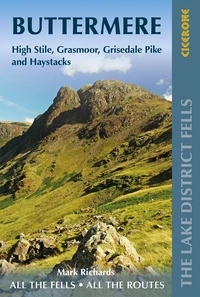Fell Walks in the Lake District
From the lofty heights of Scafell Pike, Helvellyn, and Skiddaw, to the craggy escarpments of Great Gable and the serene beauty of Cat Bells, the Lake District fells combine awe-inspiring views, pristine lakes, and lush valleys. So, whether you’re looking for a challenging trek, or a gentle walk to a viewpoint from towns like Grasmere or Ambleside, the Lakeland fells have something for everyone.

Guides and Routes
It can be overwhelming to know where to start, but our Fellranger guides are here to help. A series of eight guidebooks, one for each of the main valley bases (that’s Coniston, Keswick, Langdale, Mardale, Borrowdale, Buttermere, Wasdale and Patterdale), cover ALL the routes up ALL the fells in the area – that’s 230 fells in total!
So, whether you’d like to tick off iconic peaks like the Langdale Pikes and Coniston Old Man, or discover lesser-known gems and wilderness walking, you are bound to feel inspired to explore the timeless beauty of the Lakeland fells.

If you're interested in finding out more about the Lakeland Fell range, we have lots of resources on our site to help you plan your adventures.
Helpful Advice for Walking in the Lake District Fells
Whether you're breaking in your first pair of walking boots and pricing up your first set of walking poles, or you're bagging the last of the Wainrights on your list, there is always much to learn and enjoy.
Here are some key points to consider before you set out on your adventure.
Safety
Navigation
It’s important that you are (or become) confident in the use of a map and compass for navigating in the mountains, and well-practised before you embark on any walks on the fells. Even lower-level routes cross passes well above 600m, and although most routes generally follow well-defined paths, navigation in some remote and high places can be extremely difficult in heavy cloud or stormy weather.
Weather
Situated on the north-west coast of England, the Lake District often bears the brunt of wet and stormy weather brought on the prevailing south-westerly winds from the Atlantic Ocean. The weather can change very quickly in the mountains: a warm sunny morning can easily change within less than an hour, bringing a drop in temperature, strong winds and rain.
High-level routes can be especially difficult in bad weather and poor visibility, so you should be confident in your navigation skills. Detailed three-day weather forecasts can be obtained from the Lake District Weatherline site, the Mountain Weather Information Service and are normally pinned to noticeboards in walkers’ accommodation.
You can consult the Cicerone Navigation pocket handbook to learn essential navigational skills.
Mountain Rescue
Many callouts for the mountain rescue teams are from people who have injuries associated with a lack of sufficient training and hill fitness, as well as those who get lost. Adequate training and planning is essential to enjoying the Lake District peaks safely.
You can find more details about the Mountain Rescue teams operating in the Lake District on the Lake District Search & Mountain Rescue Association site.
Local Transport
Train
Train services provide access to Windermere and Ambleside from the West Coast Main Line at Oxenholme Lake District station near Kendal. From the north there are bus services from Penrith railway station to Keswick and Patterdale, and onwards from Keswick to Grasmere, Ambleside and Windermere.
International visitors will find Manchester Airport the most convenient, with regular train connections via Preston to Oxenholme, and on to Windermere.
Bus
For travel within the Lake District, the regular 555 bus service operates between Lancaster and Keswick, calling at Kendal, Windermere, Ambleside, Grasmere and other stops through to Keswick.
Taxi
As the region is mountainous it is important to understand that connecting by taxi or bus from one valley to another can take a very long time, and in the case of a taxi can end up being quite costly, especially in the more remote western valleys.
Accommodation
There is plentiful accommodation throughout the Lake District, although bear in mind that in the height of summer and at other peak times such as Bank Holiday weekends it may be difficult to find somewhere to stay. Booking well ahead is advisable.
The main centres in the area are Windermere, Ambleside, Coniston, Keswick and Grasmere. Smaller villages include Elterwater, Seathwaite, Eskdale Green, Nether Wasdale, Buttermere, Rosthwaite and Patterdale, all of which have more limited accommodation choices.















